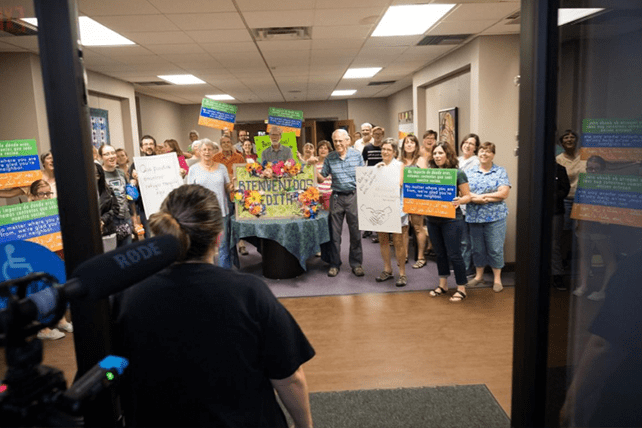(RNS) — At a congregational meeting last week, members of Columbus Mennonite Church in Ohio’s state capital gathered to figure out how they might respond to President-elect Trump’s call to enact “the largest deportation” in U.S. history.
The church has long been a part of the sanctuary movement, which offers shelter for undocumented immigrants who might otherwise be deported. During Trump’s first term, the Mennonites in Columbus gave a woman with a deportation order a place of refuge for more than three years. Now, church members wanted to consider how their ministry to migrants might look in a second Trump term.
Before they broke into groups for discussion, the congregants heard about the history of the sanctuary movement since the 1980s. They also heard from immigration lawyers about Immigration and Customs Enforcement policies that since 2011 have discouraged agents from making arrests at churches.
Last week, NBC News reported that Trump plans to rescind the policy on his first day in office.
At the end of the evening, a straw poll was taken and found broad support for continuing to provide immigrants with housing, but less support for sanctuary.
“Sanctuary just seems like a less safe strategy this time around,” concluded the Rev. Joel Miller, the church’s pastor.
Last month, a group of North Carolina church pastors who had also offered sanctuary to undocumented immigrants during Trump’s first term reached the same conclusion.
“We were all like, we just don’t feel we can tell someone entering into sanctuary right now that we could keep them safe,” said the Rev. Isaac Villegas, the former pastor of Chapel Hill Mennonite Fellowship, who attended the meeting.
During Trump’s first term, 71 undocumented immigrants with deportation orders publicly announced that they had taken sanctuary in churches across the country. Other churches may have taken in undocumented immigrants secretly, making exact numbers impossible to know.
Now, with Trump’s aggressive calls for a mass deportation targeting millions of immigrants living in the U.S., and with threats to rescind a policy that kept immigration officials from raiding churches, many congregations are feeling less certain about sanctuary.
The success of the sanctuary movement during Trump’s first term — limited as it was — lay in the fact that Immigration and Customs Enforcement agents never set foot on church grounds.
ICE agents, for the most part, respected a 2011 policy that discouraged its agents from conducting raids at so-called “sensitive locations” — churches, schools and hospitals. (Instead, they impose fines of hundreds of thousands of dollars on nine people in sanctuary for disobeying orders to leave the country. Most of those were reversed.)

